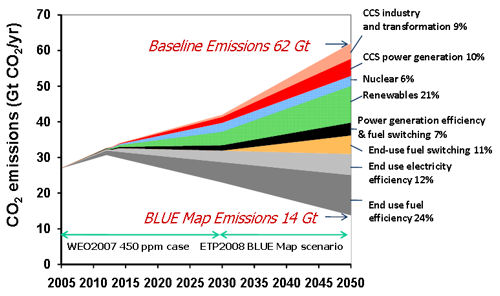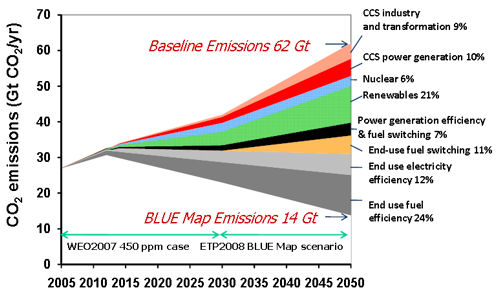Part 1 discussed the basic conclusion of the new International Energy Agency report — cutting global emissions in half by 2050 is not costly. In fact, the total shift in investment needed to stabilize at 450 ppm is only about 1.1 percent of GDP per year, and that is not a “cost” or hit to GDP, because much of that investment goes toward saving expensive fuel.
In this post, I will discuss the basic solution IEA is proposing. I will also start to look at how the report is too pessimistic about renewables, and thus it overestimates costs. In their business-as-usual baseline, neither solar thermal nor solar photovoltaics are ever commercially competitive. Part 3 discusses IEA’s very dubious assumptions in the transportation sector. The IEA assumes the price of oil is half of current levels and is frozen at $65 a barrel from 2030 to 2050. I kid you not. That is a key reason their marginal price of CO2 is so absurdly high.
My central argument in recent months has been that stabilizing at 450 ppm requires about 14 wedges — carbon mitigation strategies deployed over a few decades that ultimately each prevent the emission of one billion tons of carbon annually (see here). The IEA comes to almost exactly the same conclusion, and has relatively similar wedges, so I view this report largely as a vindication of my analysis.
The solution is some 13 wedges starting by 2015

As you can see, the IEA report concludes that a variety of technology strategies can reduce global CO2 emissions from the projected 62 Gt baseline level to 14 Gt in its “BLUE Map” scenario. Note that this is a 48 Gt drop in carbon dioxide emissions, or almost exactly a 13 GT drop in carbon emissions — 13 wedges. Each wedge is about a 7.7 percent reduction on the right hand side of the chart.
In the transportation sector, most of the “end-use fuel switching” is alternative fuels for cars divided almost equally among the following: second-generation biofuels, electric vehicles (EVs) and plug-ins, and hydrogen fuel cell vehicles (FCVs). The efficiency in transportation is largely fuel economy gains and hybrids in the medium term, but by 2050, the IEA seems to be crediting some of the efficiency to electric drives (EVs, plug-ins, and FCVs), which are indeed more efficient than internal combustion engines. The transportation analysis is the most skewed by questionable assumptions and is the focus of Part 3.
The electrifying answer
The rest of this post will concentrate on the IEA’s solution for electricity. The IEA is projecting almost a wedge of nuclear, as I do.
They have about as much efficiency as I do — roughly 3 wedges. It looks like what they call “power generation efficiency & fuel switching” is what I label cogeneration or combined heat and power. A little “end-use fuel switching” is solar space and water heating for buildings. Even more is high-efficiency heat pumps for heating and cooling.
They project almost 3 wedges of renewables for electricity generation, comprised of wind, biomass (combined cycle gasification and co-combustion with coal), solar photovoltaics, concentrated solar thermal power, geothermal, waste-to-energy, tidal, and other. I have five wedges of renewables.
They make up for the lower amount of renewables with a huge amount of carbon capture and storage (CCS), which they believe will not just extend to coal, but also natural gas, industrial processes, and “transformation” (e.g., petroleum refining). They appear to have about 2.5 wedges of CCS (whereas I have one). The IEA concludes that “technologies that already exist, or are in an advanced state of development, can bring global CO2 emission back to current levels by 2050,” but that cutting another 15 or so Gt of CO2 to get to half of current levels by 2050 will “demand deployment of technologies still under development, whose progress and ultimate success are hard to predict.” In short, we need what they call technology breakthroughs.
Let me explain why I think they have the relative contribution of renewables and CCS wrong — and why they are confused about “breakthroughs.” First off, the IEA greatly complicates its analysis by including the most expensive strategy (in terms of tons of CO2 avoided per dollar spent) as one-third of its fuel-switching in the transportation sector — hydrogen fuel cell vehicles. HFCVs clearly do require breakthroughs in hydrogen storage and the fuel cells. This assumption not only jacks up overall costs for the IEA; it means they need a large source of hydrogen, and the most obvious source is fossil fuels with CCS. I’ll discuss this further in Part 3.
Second, CCS is almost certainly going to be a high-cost solution. It must be considerably more expensive than current coal plants, which are now going for more than $5,000/kw. You probably need coal gasification, which adds even more cost, and then you need capture/separation, which adds even more cost and requires energy from the coal plant. Then you have the massive distribution infrastructure for shipping around carbon dioxide for burial. Just one wedge of CCS requires an infrastructure comparable to the entire planet’s oil delivery infrastructure. We won’t do 2.5 wedges of CCS if we have plausible renewable alternatives, but here is where the IEA assumptions really fall apart.
Third, for reasons I just cannot fathom, the IEA’s baseline or business-as-usual case, is absurdly pessimistic about renewables. For instance, their baseline for wind has “400 GW capacity by 2050.” Yet the world had a total installed capacity of almost 100 GW by the end of 2007 and we added 20 GW of wind last year alone, a 5-fold increase from 2000 (see “Wind power: a core climate solution“). If wind production just stayed at current levels, we’d have more than double the total installed wind that EIA projects for 2050. But no growth for annual wind production is itself an absurd assumption, so IEA’s wind numbers are far, far too low.
IEA’s business as usual for concentrated solar thermal electric power is “technology not commercially competitive” through the year 2050, with world capacity remaining below 10 gigawatts. That is equally absurd. CSP is, arguably, commercial now. Yes, most (but not all) CSP is currently being constructed with the help of subsidies or government renewables standards. Where would the nuclear industry be without subsidies, even today? And how much coal would we have we hadn’t exempted so many plants from having to meet clean air act standards? The world will have 10 GW of CSP by 2020, if not 2015, at which point it will be cheaper than both new coal and new nuclear. Again, I’d be happy to bet anyone that CSP will provide more power than all forms of CCS every year through 2050 (my daughter can collect the winnings).
IEA’s business as usual for solar PV is “PV remains not commercially competitive” through 2050, with total world capacity below 60 GW. But the world installed nearly 3 GW in 2007, and annual PV installations have been growing at a rate of over 50 percent a year recently (see here [PDF]). For IEA to assume average PV installations of under 2 GW a year through 2050 is, again, absurd.
The IEA assumes we need major government-funded technology breakthroughs to make PV and CSP commercial, but even the Bush administration’s own energy experts don’t think so. Steady incremental technology improvements, with learning and economies of scale, should be enough.
Bottom Line: We need about 13 wedges by 2050 to stabilize around 450 ppm (fewer wedges if we deploy them faster, more if we deploy them slower). We probably don’t need major breakthroughs — but it certainly would be a good idea to increase R&D. What we mostly need is rapid deployment of commercial and near-commercial technologies, especially renewables and efficiency.
This post was created for ClimateProgress.org, a project of the Center for American Progress Action Fund.


